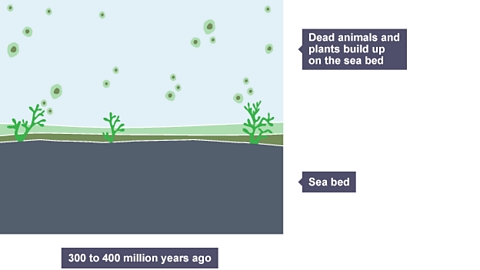Key facts
Gas, coal and oil are fossil fuels.
Using them is unsustainable because they emit carbon dioxide and other greenhouse gases that are causing global heating and climate change.
Fossil fuels are the remains of creatures and plants that lived millions of years ago. That’s the fossil bit. All of these creatures and plants contain carbon, which gives off energy when it’s burned – that’s why they are fuels.
Fossil fuels are non renewable. They take millions of years to form, so once they have all been used up, they cannot be replaced.

Fossil fuels and their impact
Find out how fossil fuels can be used to generate electricity.
Imagine the Earth millions and millions of years ago. With all sorts of weird creatures swimming about, and wonderful prehistoric forests. Amazing! Where are they all now? Here’s one preserved as a fossil, and here’s some in the gas heating your soup, and some in this coal fire, and there’s even some in that car over there – in the petrol tank. You see, gas, coal, and oil are all fossil fuels.Fossil fuels are the remains of creatures and plants that lived millions of years ago. That’s the fossil bit. All of these creatures and plants contain carbon, which gives off energy when it’s burned; that’s why they’re fuels.
Both oil and gas come from layers of dead marine organisms such as tiny animals and plant life like plankton. When they died, their bodies fell to the bottom of the sea. Over millions of years layers of mud and rock built up over them, which put them under massive pressure. This, together with the geothermal heat from the Earth’s mantle, changed them into oil and gas.
When we burn them, we are changing the chemical energy stored in them into heat energy. That heat energy can then warm our homes or be used to generate electricity. Oil is also used to make plastics, such as plastic bags, plastic furniture, and synthetic clothes.
Coal doesn’t come from sea creatures, coal comes from dead trees from ancient forests buried underground over millions of years which we then extract by mining. Around the world, coal is burned for heating and also used in power stations. In china, approximately 58 percent of the electricity generated is produced by burning coal.
In Scotland, we don’t mine coal anymore but we still have over 100 oil rigs out in the North Sea and they employ a lot of people.There are two major problems with fossil fuels that we can’t avoid. The first is that they are bad for our planet. When fossil fuels are burned, they release carbon dioxide which helps cause global warming. The other problem is that they are non-renewable. Burning fossil fuels also causes a lot of pollution. It can affect the quality of the air we breathe and make people ill.
We know we have to stop using fossil fuels but at the moment we still depend on them for fuel, heating, and making other products.Stopping using them will mean some tough decisions. What could you do without?
How fossil fuels are formed
How oil and gas are formed
1 of 3
- Both oil and gas come from layers of dead marine organisms, such as tiny animals and plant life, like plankton.
- When they died, their bodies fell to the bottom of the sea. Over millions of years, layers of mud and rock built up over them which put them under massive pressure.
- This, together with the geothermalAn energy resource from the thermal energy store of hot rocks in the Earth. heat from the earth’s mantle, changed them into oil and gas.
How coal is formed

- Coal comes from dead trees from ancient forests.
- Over time these become buried under layers of soil and other material.
- This build up of material creates huge pressure.
- Over millions of years this pressure combined with geothermal heat compresses the dead trees into coal.

Extracting fossil fuels
Fossils fuels are still important to Scotland. We don’t mine coal anymore, but we still have over 100 oil and gas rigs out in the North Sea and they employ a lot of people
Gas and oil drilling

Oil and gas can be found stored in reservoirs deep underground or beneath the sea. Drilling machines are used to reach the fuels which can then be transported to the surface through pipes.
Scotland's oil and gas come from reserves under the North Sea which are reached using surface drilling rigs.
Extracting oil and gas can cause pollution to the sea and seabed around where drilling takes place. Oil spills can pollute wider areas and harm wildlife and habitats over periods of years.

Coal mining
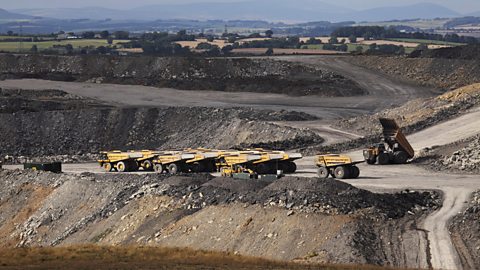
Coal consists of carbon with organic and inorganic compounds. It is mined from seams of coal found between layers of rock in the ground.
Where the coal is deep below the surface,underground mining or deep mining methods are used. This involved digging deep shafts and tunnels to allow miners and machinery to reach the coal seams.
Where the coal is at a shallow depth, open cast mining or surface mining is used. This involves using machinery or explosives to remove the layers of soil and rock above the coal seam.
Both types of mining cause air, water and soil pollution which can damage human health and the local environment and waterways.

Oil refining
Crude oil is made up a mixture of different hydrocarbons - substances made from carbon and hydrogen only. These hydrocarbons have different properties and can be used for different purposes.
Fractional distillation is used to separate crude oil into simpler, more useful mixtures. This method can be used because the different hydrocarbons have different boiling points.
During the fractional distillation of crude oil:
- Heated crude oil enters a tall fractionating column, which is hot at the bottom and gets cooler towards the top.
- Vapours from the oil rise through the column.
- Vapours condense into liquids when they become cool enough.
- Different liquids are let out of the column at different heights.
- The smallest hydrocarbon molecules do not condense, but leave the column as gases.
- Long hydrocarbon molecules have high boiling points and so they do not evaporate into gases. They leave the column as hot liquid bitumen.
The different, useful mixtures are called fractions. This is because they are only part of the original crude oil.
How fossil fuels are used
Fossil fuels as energy sources
The main use of fossil fuels is burning them as fuel. When they burn the chemical energy stored in them is transferred into heat energy.
That heat energy can then be used in a number of ways:
- Gas is burned in our homes to provide central heating and to cook food.
- Petrol and diesel from oil are burned to move pistons in engines to make cars and other vehicles move.
- Coal, gas and oil can all be burned in power stations to generate electricity.
Generating electricity
Around the world, coal is burned for heating and also used in power stations. In China, more than half the electricity generated is produced by burning coal
Making plastics
While plastics can be made from plants, most of the plastics we use every day are made from crude oil.
When crude oil is distilled, one of the fractions produced is a chemical called naphtha.
The naphtha then goes through a process called cracking, which breaks it down into small molecules called monomers. These can be joined together in chains called polymers. For example the monomer ethene is joined in chains to make the plastic polyethene or polythene.
Making steel
Coal is used to turn iron ore into steel.
The coal acts as a fuel that heats a blast furnace. As the coal burns, it produces carbon monoxide gas. This releases oxygen from the iron ore, leaving iron metal. Limestone and other materials are added to remove impurities.
It its pure form, iron is a relatively soft metal. Adding small amounts of carbon to iron to produce steel creates a much stronger alloy.
Sustainability of fossil fuels
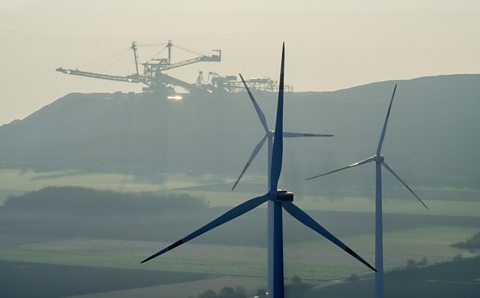
To develop a sustainable future you need to think about meeting today's needs and protecting the environment and resources for the future.
Burning fossil fuels is not sustainable. It creates carbon dioxide which traps energy from the Sun in the Earth's atmosphere. This is a major cause of global heating.
Other gases released cause pollution which is bad for our health and for other living things.
Extracting fossil fuels can cause local environmental damage. Oil leaks and frackingRemoving oil and gas that is trapped in underground rock by injecting liquid into the rock at high pressure. can pollute ground and water and harm wildlife.
Advantages and disadvantages of using fossil fuels
Advantages
- They generate large amounts of energy quite cheaply.
- They can be easy to use. Burning coal or gas only needs a flame source and oxygen supply.
- They are portable - Oil and gas can be transported through pipelines. Petrol and other fuels can be stored in tanks and easily transferred to cars and other vehicles.
Disadvantages
- Fossil fuels are bad for our planet. When fossil fuels are burned, they release carbon dioxide – which is one of the greenhouse gasA gas that absorbs heat so that it is trapped in the Earth's atmosphere. Greenhouse gases help keep the Earth warm but increasing amounts of greenhouse gases causes global heating. The main greenhouse gases are water vapour, carbon dioxide and methane that cause global heating.
- Burning fossil fuels also causes a lot of pollution. It can affect the quality of the air we breathe and make people ill. It can even kill people.
- Mining can create ugly scars on the landscape and destroy wildlife habitats.
- Oil spills can cause environmental damage harming aquatic wildlife.
- Oil is mainly produced outside the UK, so prices are set by other countries.
- Fossil fuels are non-renewable. This means there’s only so much of them and once we’ve run out, that’s it, there's no more.
Test your knowledge
More on Energy sources and sustainability
Find out more by working through a topic
Generating electricity
- count4 of 12
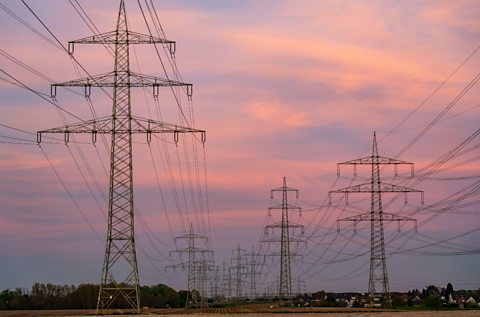
Geothermal power
- count5 of 12
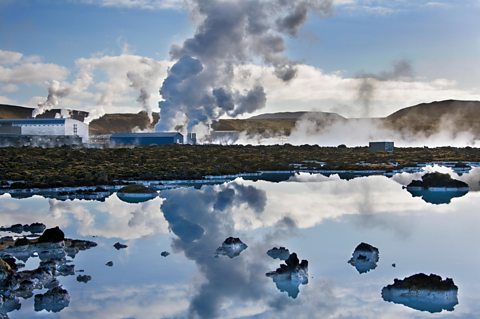
Hydroelectric power
- count6 of 12
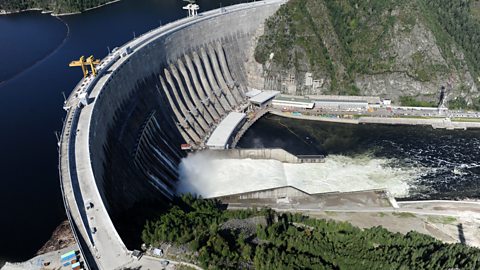
Nuclear power
- count7 of 12

